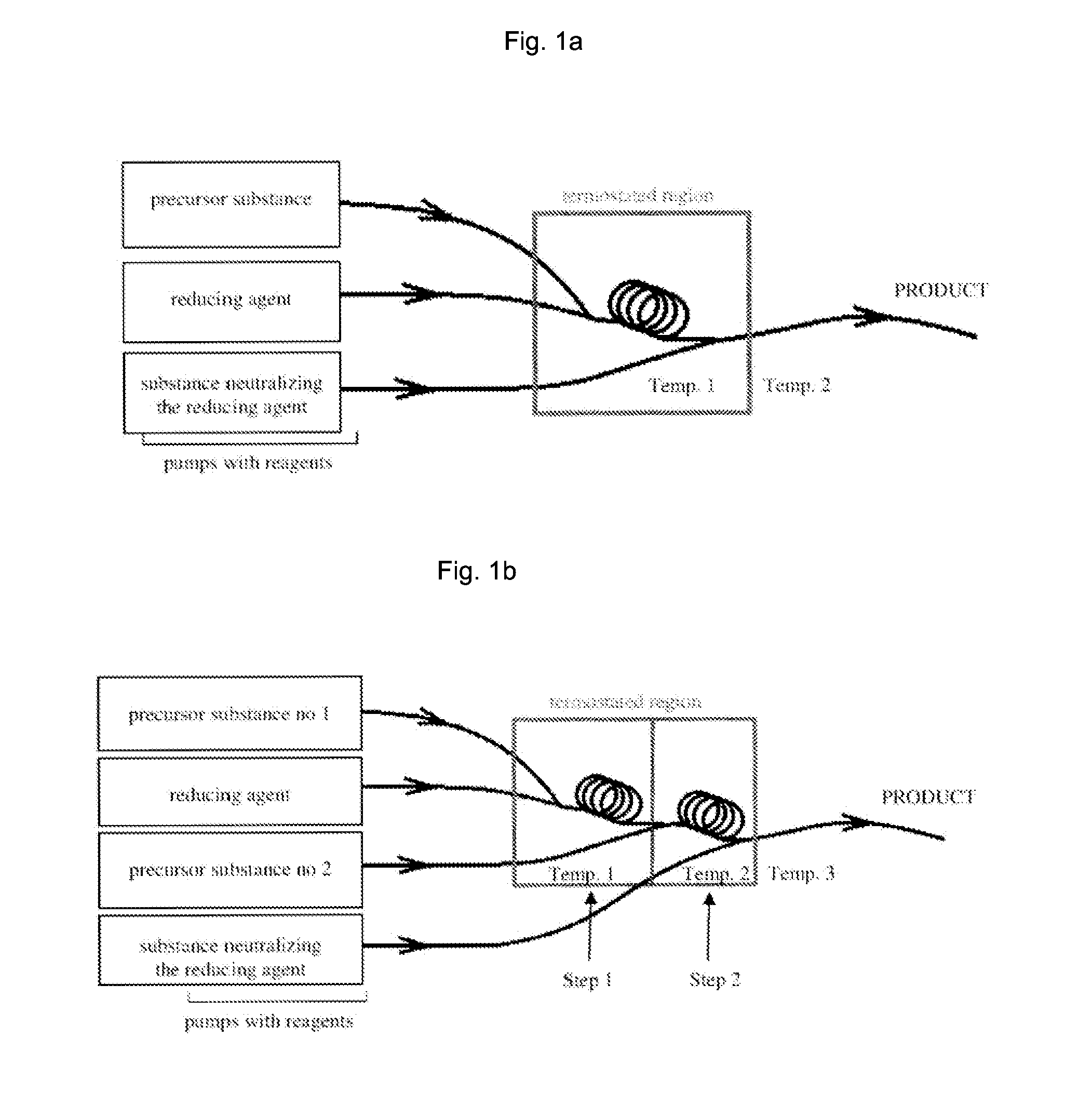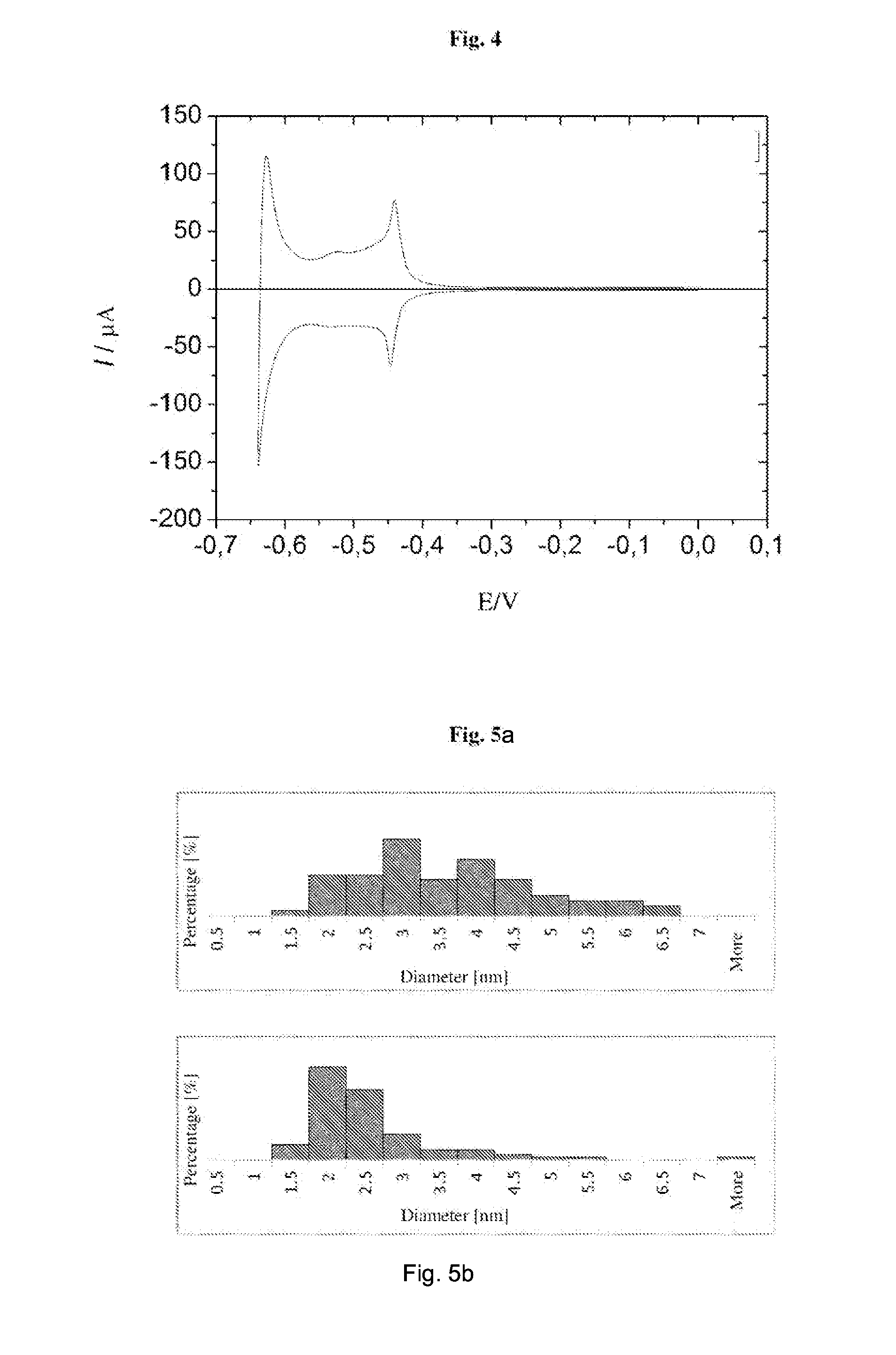Flow system method for preparing substantially pure nanoparticles, nanoparticles obtained by this method and use thereof
a flow system and nanoparticle technology, applied in the direction of metal/metal-oxide/metal-hydroxide catalyst, chemical/physical process, powder delivery, etc., can solve the problems of nanoparticle synthesis, unfavorable use of stabilizing agents, and disadvantages of surfactants and other organic molecules as stabilizing agents, and achieve high stability
- Summary
- Abstract
- Description
- Claims
- Application Information
AI Technical Summary
Benefits of technology
Problems solved by technology
Method used
Image
Examples
example 1
Synthesis of Palladium Nanoparticles of Controlled Size and Their Properties Characteristic
[0086]A) Reduction reaction is carried out in the continuous flow system presented in FIG. 1a, in a Teflon tube having the inner diameter of 1 / 32″ and length of 40 cm, wherein the flow rate of the reagents in the reaction tube is 200 ml / h.
[0087]Aqueous solution of 10 mM palladium (II) nitrate (Pd(NO3)2) is used to obtain a stable colloid of palladium nanoparticles. 20 mM aqueous solution of hydrazine is used as the reducing agent.
[0088]The reaction is carried out in temperature of 40° C., and 35 mM solution of hydrogen peroxide is used to terminate the reaction.
[0089]A stable black colloid of palladium nanoparticles is the product of the reaction. The metal concentration in the obtained colloid amounts to about 360 ppm. The colloid obtained is stable for a period of 4 months (or even longer) without a need for mixing and / or sonication in the ultrasonic bath.
[0090]A TEM micrograph of palladium ...
example 2
Synthesis of Palladium Nanoparticles Having Controlled Size in a Powder Form
[0109]A portion of the colloid obtained in Example 1A-C was centrifuged, subsequently dried and black powder was obtained.
example 3
Synthesis of Copper (I) Oxide Nanoparticles of Controlled Size and Their Properties Characteristic
[0110]Reduction reaction is carried out in the continuous flow system presented in FIG. 1a, in a Teflon tube having the inner diameter of 1 / 32″ and length of 40 cm, wherein the flow rate of the reagents in the reaction tube is 200 ml / h.
[0111]Aqueous solution of 10 mM Cu(NO3)2 is used to obtain a stable colloid of copper (I) oxide nanoparticles. 20 mM aqueous solution of hydrazine is used as the reducing agent. The reaction is carried out in temperature of 40° C., and 3,79 mM solution of hydrogen peroxide with addition of 2,69 mM NaOH (pH≈12) is used to terminate the reaction. The obtained colloid solution has pH≈7.
[0112]A stable orange-yellow colloid of copper (I) oxide nanoparticles is the product of the reaction. The colloid obtained is stable for a period of 2 weeks (or even longer) without a need for mixing and / or sonication in the ultrasonic bath.
[0113]A representative chronovoltam...
PUM
| Property | Measurement | Unit |
|---|---|---|
| band gap | aaaaa | aaaaa |
| temperature | aaaaa | aaaaa |
| temperature | aaaaa | aaaaa |
Abstract
Description
Claims
Application Information
 Login to View More
Login to View More - R&D
- Intellectual Property
- Life Sciences
- Materials
- Tech Scout
- Unparalleled Data Quality
- Higher Quality Content
- 60% Fewer Hallucinations
Browse by: Latest US Patents, China's latest patents, Technical Efficacy Thesaurus, Application Domain, Technology Topic, Popular Technical Reports.
© 2025 PatSnap. All rights reserved.Legal|Privacy policy|Modern Slavery Act Transparency Statement|Sitemap|About US| Contact US: help@patsnap.com



